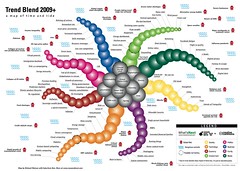The following is an idea and article from my amazing colleague Lucy Freeman. As outreach librarian and early childhood specialist, she makes me and all her colleagues look soooo good. Below is one of her delightful ideas that has developed a life of its own. It is inexpensive and easy to replicate anywhere where young children come to libraries. Here's Lucy:
While I love doing story time and think it provides many valuable experiences, skills and knowledge, I also feel that children don’t get enough free play time. Remembering many fun hours playing with boxes when I was a child, I wanted to re-create that experience for the toddlers in my story time group.
Since I also host a monthly training program for child care providers, I decided to involve them also. A local appliance store provided refrigerator boxes for free. They also provided other sized boxes and some interesting packing materials that the child care providers used in very creative ways. Glue guns, gorilla glue, cloth scraps, wood and plastic spools, plenty of knives and scissors and yarn were used to fashion the boxes into wonderful playthings.
The child care providers had a great time using their creativity but also thinking just what their center and their children would like and use. One group grabbed a large hunk of bright yellow felt and used it to cover a long box. With the addition of wheels, steering wheel and fold-out stop sign a simple box became a darling school bus. Fancy shaped wooden dowels inspired another group to make a castle, complete with marker drawn vines on the walls.
The participants, about 30 people from 11 different centers, worked for almost two hours on their creations. They wrote their name or center, along with the address, on their box. This was so I could deliver them to the appropriate center once I was done using them with my toddler story groups.
I arranged the boxes into several “stations” adding appropriate props to go with them for play. One corner was the kitchen with a stove, refrigerator and table and chairs, all made from boxes. A few pots and pans, plates and glasses, hot pad, cookie sheet and spoons made for some great imaginative play opportunities.
Another corner was the bedroom with a cradle, book shelf and toy box made out of boxes. A few books, stuffed animals and dolls and this spot was a hit with the tots also.
The school bus, along with an RV, was put in the center of the room for the children to climb into and pretend to drive. A wonderful hot dog stand with a window to make orders at and outside seating to eat your meal just needed a few plastic baskets, napkins, glasses and play money to make for lots of interaction between the children.
One huge box turned into a castle with vines curling on its “stone” walls and purple fabric draping its doorway. The children dragged my story time unicorn into the castle and imagined themselves princes and princesses.
Probably the most popular box was simply a house with plastic flowers to water outside, windows to peek out and blankets inside to cuddle in. At one point the children gathered every stuffed animal I had placed around the room and put them all to bed in the house, carefully tucked in under the blanket.
I also put out a display of books emphasizing imaginative play, hoping that the parents would read them and be further inspired to welcome free play into their children’s lives. One mother spent a lot of time reading, not only to her own child, but to several other children. A list of the books is shown below.
Three toddler story groups had a chance to play at “Box Town” along with another group at a neighborhood center. Then the boxes were loaded on our library van and delivered to the various child care centers that made them to be used by their children.
We have so many events for children where everything is structured and there is little chance for individual imaginative play or creativity. Even in story time, I sometimes regret the special little moments that I have to pass by because of the needs of the larger group that I am responsible for. Sometimes those little questing minds have to be quieted so that the story line continues for the larger group. But in free play, those curious minds are liberated to ask questions, transform boxes into cars, and start to imagine their futures.
It was wonderful watching the children play with such simply made and cheap props. While they were mostly two year olds and didn’t really know each other, they played with very little supervision or direction. Their imaginations created countless scenarios as they made dinner and served it to their dad, or drove children to school in the bus or charged $15 for a hot dog and gave back $100 in change! Watching the imaginative and peaceful play, many parents planned on going home and making their own version of “Box Town.”
I recently visited one of the day care centers that participated in the program. They are still using the boxes they made back in March but have added some new ones. One classroom just had the children paint apple boxes and then they called them boats and sailed around the linoleum floor. In another classroom with smaller children, the teachers made a darling boat complete with a sail. The children were sitting inside waving their Fourth of July flags and rowing with the paddles, sticks with cardboard paddles taped on the end!
Book List
Six Sticks by Molly Coxe
A Box Can Be Many Things by Dana Meachen Rau
The Gift of Nothing by Patrick McDonnell
The Saucepan Game by Jan Ormerod
Roxaboxen by Alice McLerran
The Can by Rita Golden Gelman
What Good is a Tree? by Larry Brimner
Not a Box by Antoinette Portis













